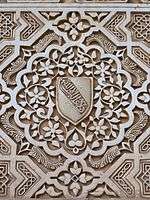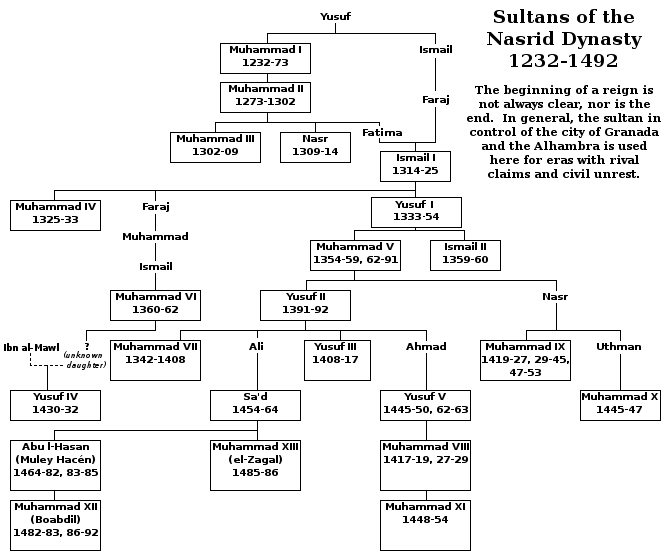Nasrid dynasty
The Nasrid dynasty (Arabic: بنو نصر banū Naṣr or banū al-Aḥmar; Spanish: Nazarí) was the last Muslim dynasty in the Iberian Peninsula, ruling the Emirate of Granada from 1230 until 1492.[1] The Nasrid dynasty rose to power after the defeat of the Almohad Caliphate in 1212 at the Battle of Las Navas de Tolosa. Twenty-three emirs ruled Granada from the founding of the dynasty in 1230 by Muhammad I until 2 January 1492, when Muhammad XII surrendered all lands to Queen Isabella I of Castile. Today, the most visible evidence of the Nasrid dynasty is part of the Alhambra palace complex built under their rule.
| Nasrid dynasty بنو نصر | |
|---|---|
.svg.png) | |
| Parent house | Banu Khazraj |
| Country | Emirate of Granada |
| Founded | 1230 |
| Founder | Muhammad I of Granada |
| Final ruler | Muhammad XII of Granada |
| Deposition | 2 January 1492 (Treaty of Granada) |
| History of Al-Andalus |
|---|
|
Muslim conquest (711–732) |
|
Umayyads of Córdoba (756–1031) |
|
|
First Taifa period (1009–1110) |
|
Almoravid rule (1085–1145) |
|
Second Taifa period (1140–1203) |
|
Almohad rule (1147–1238) |
|
Third Taifa period (1232–1287) |
|
Emirate of Granada (1238–1492) |
| Related articles |
| Historical Arab states and dynasties | ||||||||||||||||||||||||||||||||||||||||||||||||||||||||||
|---|---|---|---|---|---|---|---|---|---|---|---|---|---|---|---|---|---|---|---|---|---|---|---|---|---|---|---|---|---|---|---|---|---|---|---|---|---|---|---|---|---|---|---|---|---|---|---|---|---|---|---|---|---|---|---|---|---|---|
 | ||||||||||||||||||||||||||||||||||||||||||||||||||||||||||
|
Ancient Arab States
|
||||||||||||||||||||||||||||||||||||||||||||||||||||||||||
|
Arab Empires
|
||||||||||||||||||||||||||||||||||||||||||||||||||||||||||
|
Eastern Dynasties
|
||||||||||||||||||||||||||||||||||||||||||||||||||||||||||
|
Western Dynasties
|
||||||||||||||||||||||||||||||||||||||||||||||||||||||||||
|
Arabian Peninsula
|
||||||||||||||||||||||||||||||||||||||||||||||||||||||||||
|
East Africa
|
||||||||||||||||||||||||||||||||||||||||||||||||||||||||||
|
Current monarchies
|
||||||||||||||||||||||||||||||||||||||||||||||||||||||||||
Background
The dynasty founded by Muhammad I of Granada held a territory that included Granada, Jaén, Almería, and Málaga. Valencia, Xàtiva, and Jaén were conquered by Christians during the campaigns of the Reconquista and the Nasrids were made into tribute paying vassals in 1243. Granada continued as a center of Islamic culture. The Nasrids formed alliances with the Marinids of the Maghreb. [2]
Nasrid crafts like textile work such as ceramic overglaze used techniques from 9th century Baghdad and were applied to make lusterware, first in Málaga, Murcia, and Almería, and then by the 15th century in Manises. This style of pottery produced first under Muslim patronage, then Christian, influenced the later style of colorful and glazed Italian ceramics known as maiolica. Throughout the 14th century the Nasrids are noted for their palace architecture like the Alhambra, which was a product of the efforts of Ismail I and Muhammad V.[2]
In 1469 Ferdinand II of Aragon married Isabella I of Castile, uniting the Christian Kingdoms of Castile and Aragon in a common cause dedicated to purging Islam from the Iberian Peninsula. The last Nasrid ruler Muhammad XII of the Emirate of Granada was exiled to the Maghreb in 1492 and the remaining Muslim population was given the status of mudéjar.[2]
 Coat of Arms of the Emirate of Granada on a wall in the Alhambra, Nasrid dynasty (1013–1492)
Coat of Arms of the Emirate of Granada on a wall in the Alhambra, Nasrid dynasty (1013–1492) Contemporary coat of arms (upper right) of the Nasrid dynasty of Granada with garbled Arabic inscription (Wernigerode Armorial).
Contemporary coat of arms (upper right) of the Nasrid dynasty of Granada with garbled Arabic inscription (Wernigerode Armorial).
%2C_10_kings_cropped.jpg) Painting in the ceiling of the Hall of Kings of the Alhambra, likely depicting ten Sultans of Granada.
Painting in the ceiling of the Hall of Kings of the Alhambra, likely depicting ten Sultans of Granada.
Lineage
The Nasrid dynasty was descended from the Arab Banu Khazraj tribe,[5] and claimed direct male-line descent from Sa'd ibn Ubadah, the chief of the tribe and one of the companions of the Islamic prophet Muhammad. The nasab of Yusuf (nicknamed "al-Ahmar", meaning "the Red").[6] The Nasrids were of Azd origin.
Conflicts of succession and civil war
During the time the Christians were launching a campaign against the Emirate of Granada that would effectively end the Nasrid dynasty, the Nasrids were engaged in a civil war over the throne of Granada. When Abu l-Hasan Ali, Sultan of Granada, was ousted by his son Muhammad XII, Abu l-Hasan Ali retreated to Málaga and civil war broke out between the competing factions. Christians took full advantage of this and continued capturing Muslim strongholds. Muhammed XII was caught by Christian forces in 1483 at Lucena, Córdoba. He was freed after he swore an oath of allegiance to Ferdinand II of Aragon and Isabella I of Castile. Abu l-Hasan Ali finally abdicated in favor of his brother Muhammad XIII, Sultan of Granada, known as Al-Zaghal (the valiant), and a power struggle with Muhammad XII continued. Al-Zaghal prevailed in the inner struggle but was forced to surrender to the Christians. Muhammad XII was given a lordship in the Alpujarras mountains but instead took financial compensation from the Spanish crown to leave the Iberian Peninsula.[7]
Legacy
The Nasrid dynasty was one of the longest ruling Muslim dynasty in the Iberian Peninsula, reigning for more than 250 years from the establishment of the Emirate of Granada in 1230 to its annexation in 1492. The Nasrids constructed the Alhambra palace-fortress complex in Granada.
Family tree
The family tree below shows the genealogical relationship between each sultan of the Nasrid dynasty.[8] It starts with their common ancestor, Yusuf al-Ahmar. Daughters are omitted, as are sons whose descendants never reigned. During times of rival claims to the throne, the family tree generally recognizes the sultan who controlled the city of Granada itself and the Alhambra palace.
List of Nasrid sultans of Granada
the Iberian Peninsula |
| al-Andalus |
| Almohads |
| Almoravids |
Aragon
|
| Asturias |
Castile
|
| Catalonia |
| Córdoba Emirate · Caliphate
|
| Galicia |
| Granada |
| León |
| Majorca |
Navarre
|
Portugal
|
| Spain Medieval · Modern
|
| Suebi |
| Taifas |
| Valencia |
| Viguera |
| Visigoths |
First dynasty (al-dawla al-ghalibiyya):[9]
- Abu Abdallah Muhammad I al-Ghalib bi'llah (1238–1273)[10]
- Abu Abdallah Muhammad II al-Faqih (1273–1302)[10]
- Abu Abdallah Muhammad III al-Makhlu (1302–1309)[10]
- Abu'l-Juyush Nasr (1309–1314)[10]
Second dynasty (al-dawla al-isma'iliyya al-nasriyya):[9]
- Abu'l-Walid Ismail I (1314–1325)[10]
- Abu Abdallah Muhammad IV (1325–1333)[10]
- Abu'l-Hajjaj Yusuf I al-Muayyad bi'llah (1333–1354)[10]
- Abu Abdallah Muhammad V al-Ghani bi'llah (1354–1359, 1362–1391)[10]
- Abu'l-Walid Ismail II (1359–1360)[10]
- Abu Abdallah Muhammad VI al-Ghalib bi'llah (1360–1362), known as "The Red King" (el rey Bermejo)[10]
- Abu'l-Hajjaj Yusuf II al-Mustaghni bi'llah (1391–1392)[10]
- Abu Abdallah Muhammad VII (1392–1408)[10]
- Abu'l-Hajjaj Yusuf III al-Nasir li-Din Allah (1408–1417)[10]
- Muhammad VIII al-Mutamassik (1417–1419, 1427–1429), known as "the Little One" (al-Saghir/el Pequeño)[10]
- Abu Abdallah Muhammad IX al-Ghalib bi'llah (1419–1427, 1430–1431, 1432–1445, 1447–1453), known as "the Left-Handed" (al-Aysar/el Zurdo)[10]
- Abu'l-Hajjaj Yusuf IV (1431–1432), known as Ibn al-Mawl or Abenalmao[10]
- Abu Abdallah Muhammad X (1445, 1446–1447), known as "The Lame" (al-Ahnaf/el Cojo)[10]
- Yusuf V (1445–1446, 1462), known as Ibn Ismail or Aben Ismael[10]
- Muhammad XI (1451–1455), known as "The Little Fellow" (el Chiquito)[10]
- Abu Nasr Sa'd al-Mustain bi'llah (1454–1464), known as Ciriza and Muley Zad[10]
- Abu'l-Hasan Ali, known as Muley Hacén (1464–1482, 1482–1485)[10]
- Abu Abdallah Muhammad XII, known as Boabdil (1482, 1486–1492)[10]
- Abu Abdallah Muhammad XIII, known as "The Brave" (al-Zaghal/el Zagal) (1485–1486)[10]
Notes
- Miranda 1970, p. 429.
- "The Art of the Nasrid Period (1232–1492)". Metropolitan Museum of Art. Retrieved 17 September 2019.
- "Textile Fragment". The Metropolitan Museum of Art. Retrieved 2018-12-14.
- Ekhtiar, Maryam (2011). Masterpieces from the Department of Islamic Art in The Metropolitan Museum of Art. New York: The Metropolitan Museum of Art. p. 82.
- Hitti, Philip K. (2002). History of The Arabs. Palgrave Macmillan. p. 549. ISBN 9781137039828.
- Fierro, Maribel (2014). "Ways of Connecting With the Past: Genealogies in Nasrid Granada". Genealogy and Knowledge in Muslim Societies. pp. 71–88. doi:10.3366/edinburgh/9780748644971.003.0006. hdl:10261/116998. ISBN 9780748644971.
- Barton, Simon (2009). A History of Spain. London: Palgrave Macmillan. p. 104. ISBN 978-0-230-20012-8.
- Lane-Poole, Stanley (1894). The Mohammedan Dynasties: Chronological and Genealogical Tables with Historical Introductions. Westminster: Archibald Constable and Company. p. 29. OCLC 1199708.
- Fernández-Puertas 1997, p. 4.
- Latham & Fernández-Puertas 1993, p. 1020.
Bibliography
- Fernández Puertas, Antonio (1997). The Alhambra. Vol 1. From the Ninth Century to Yusuf I (1354). Saqi Books. ISBN 0-86356-466-6.
- Fernández Puertas, Antonio (1997). The Alhambra. Vol. 2. (1354–1391). Saqi Books. ISBN 0-86356-467-4.
- Harvey, Leonard Patrick (1992). Islamic Spain 1250 to 1500. University of Chicago Press. ISBN 0-226-31962-8.
- Watt, W. Montgomery (1965). A History of Islamic Spain. Edinburgh University Press. ISBN 0-7486-0847-8.
- Arié, Rachel (1990). L'Espagne musulmane au Temps des Nasrides (1232–1492) (in French) (2nd ed.). De Boccard. ISBN 2-7018-0052-8.
- Bueno, Francisco (2004). Los Reyes de la Alhambra. Entre la historia y la leyenda (in Spanish). Miguel Sánchez. ISBN 84-7169-082-9.
- Cortés Peña, Antonio Luis; Vincent, Bernard (1983–1987). Historia de Granada. 4 vols (in Spanish). Editorial Don Quijote.
- Miranda, Ambroxio Huici (1970). "The Iberian Peninsula and Sicily". In Holt, P.M; Lambton, Ann K.S.; Lewis, Bernard (eds.). The Cambridge History of Islam. Vol. 2A. Cambridge University Press.CS1 maint: ref=harv (link)
- Fernández-Puertas, Antonio (April 1997). "The Three Great Sultans of al-Dawla al-Ismā'īliyya al-Naṣriyya Who Built the Fourteenth-Century Alhambra: Ismā'īl I, Yūsuf I, Muḥammad V (713–793/1314–1391)". Journal of the Royal Asiatic Society. Third Series. 7 (1).CS1 maint: ref=harv (link)
- Latham, J.D. & Fernández-Puertas, A. (1993). "Naṣrids". In Bosworth, C. E.; van Donzel, E.; Heinrichs, W. P. & Pellat, Ch. (eds.). The Encyclopaedia of Islam, New Edition, Volume VII: Mif–Naz. Leiden: E. J. Brill. pp. 1020–1029. ISBN 90-04-09419-9.
